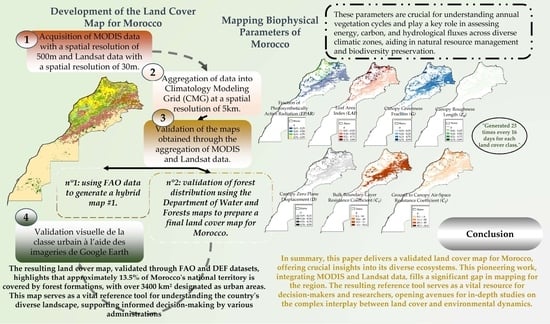Using Satellite Data to Characterize Land Surface Processes in Morocco
Abstract
:1. Introduction
2. Materials and Methods
2.1. Study Area
2.2. Data
2.2.1. MODIS Data
2.2.2. Landsat Data
2.3. Methods
2.3.1. Development of Land-Cover Maps
- The different land cover types were aggregated from MCD12Q1 at 500 m and their fractions in a 0.05° × 0.05° (equivalent to 5 km × 5 km) Climate Modeling Grid (CMG) were obtained.
- The 30 m × 30 m Landsat ISAs were also aggregated to 0.05° × 0.05° and co-registered in the same CMG.
- These Landsat ISA fractions were imposed into the CMG as a replacement for the urban fraction from MODIS.
2.3.2. Validation of the Land Use Map
- If FAO type LCXX and the same MODIS type LCXX exist in the pixel, it is inferred that type LCXX exists at this pixel, and the MODIS classification is confirmed.
- If the FAO LCXX type exists but the same MODIS LCXX type does not exist in the pixel, it is inferred that the LCXX type exists at the pixel level, and the MODIS classification is invalid.
- If the FAO type LCXX does not exist, but the MODIS type LCXX exists in the pixel, it is inferred that the LCXX type does not exist at this pixel. In this case, the MODIS classification is invalidated, and the FAO type is substituted for the MODIS type.
2.3.3. Biophysical Parameters
- Fraction of Photosynthetically Active Radiation «FPAR»: represents the portion of incoming solar radiation absorbed by green vegetation within the visible spectral range of 0.4-0.7 μm. FPAR is a crucial biophysical parameter that plays a significant role in characterizing processes like photosynthesis and the exchange of energy and water between vegetation and the atmosphere. Moreover, it finds extensive applications in monitoring various aspects, including crop growth status, drought conditions, changes in land use, and vegetation dynamics like phenology [33]. Due to its significance, FPAR has been recognized as one of the Essential Climate Variables (ECV) by both the Global Terrestrial Observing System (GTOS) and the Global Climate Observing System (GCOS) [34].Satellite observation stands out as the sole method capable of providing FPAR data with spatiotemporal coverage on both regional and global scales. Numerous studies have underscored the notion that an increasing proportion of diffuse radiation can enhance the efficiency of light utilization [35,36,37], even though the overall photosynthetically active radiation reaching the canopy top may have decreased. In various regions around the world, recent research has demonstrated a trend of diminishing total radiation alongside an increase in the fraction of diffuse radiation. For instance, Zhu et al. [38] reported a substantial decrease in total radiation over the past five decades in China. This finding holds significant importance for global climate change investigations, particularly concerning atmospheric, water, and vegetation cycles, and has a direct impact on the accuracy of carbon budget estimations [39,40,41].The Fraction of Absorbed Photosynthetically Active Radiation (FPAR) is calculated using the SiB2 model, which involves several parameters and mathematical equations to estimate the amount of incoming photosynthetically active radiation absorbed by vegetation. The specific formula used for FPAR calculation is as follows:where the vegetation index by quotient SR:And:;;the SR value corresponding to the percentile 98% of the NDVI for vegetation type i;: the SR value corresponding to the percentile 5% of the NDVI for vegetation type i.
- Leaf Area Index «LAI»: is a measure that quantifies the extent of leaf area present within an ecosystem. It holds significant importance in various ecological processes, including photosynthesis, respiration, rainfall interception [42,43,44], as well as calculations related to albedo and surface roughness. LAI, being a fundamental characteristic of vegetation, has been recognized as a pivotal climate variable within the realm of global climate change research [45].
- Canopy Greenness Fraction «G»: Represents the proportion of soil that is covered by green vegetation. In practical terms, it serves as a measure of the spatial coverage of vegetation. One notable advantage of using this fraction is that it is not influenced by the direction of lighting and is highly responsive to the quantity of vegetation present. Due to these characteristics, the fraction G is a promising alternative to traditional vegetation indices for monitoring ecosystems [46].
- Canopy Roughness Length: Denoted as Z0, is a critical parameter employed in numerical models to characterize surface roughness. This parameter exerts influence over the strength of mechanical turbulence and the exchanges of turbulent properties above the surface. Z0 is determined by considering the frontal area of the average surface element (facing the wind) divided by the ground area it occupies. In the context of sub-grid scale vertical heat exchange, which occurs through turbulent eddies, this can be expressed as the vertical gradient of potential temperature multiplied by the roughness length. A shorter roughness length signifies reduced exchange between the Earth’s surface and the atmosphere. However, it also corresponds to a more robust near-surface wind flow, particularly at the standard height of 10 m above ground level [47].
- Canopy Zero Plane Displacement: In turbulent airflow over rough surfaces with significant roughness elements, a height scale represents a specific vertical distance that characterizes the average level of momentum transfer between the moving air and the roughness elements. In conditions of neutral stability, the logarithmic wind profile assumes a linear shape only when the zero-plane displacement length adjusts the vertical axis. Various formulas are available to establish a connection between this height scale and the geometric attributes of the roughness elements, such as silhouette spacing and area. Tables containing precomputed values for different surface types can be found in many micro-meteorological references, such as [48]. These tables provide valuable data for assessing and modeling turbulent flows over diverse terrains and surfaces.
- Bulk Boundary-Layer Resistance Coefficient and the Ground to Canopy Air-Space Resistance Coefficient: In the article [49], the significance of boundary resistance coefficient and ground to canopy air space resistance coefficient in energy efficiency is discussed in detail. The authors suggest that the boundary resistance coefficient is a measure of the resistance to air flow between two surfaces and is important in determining the energy efficiency of a building. Similarly, the ground to canopy air space resistance coefficient is the resistance to air flow between the surface and the canopy of a building and impacts the energy efficiency of the building. As such, it is clear that understanding the significance of boundary resistance coefficient and ground to canopy air space resistance coefficient is essential in order to maximize energy efficiency.In 2008, DJ Sailor published a study in the journal Elsevier on energy and buildings. This study explored the advantages and disadvantages of two different thermal resistance coefficients, boundary resistance coefficient and ground to canopy air space resistance coefficient. The boundary resistance coefficient is a measure of the amount of heat that is transferred between two objects or layers, such as building walls or natural surfaces [50].In a 2015 study conducted by V Kapsalis and D Karamanis of Energy and Buildings, the impact of boundary and ground to canopy air space resistance coefficients on heat transfer was explored. The authors used a two-dimensional numerical model to calculate the convective heat exchange between the canopy and the ground, as well as the air temperature near the ground. The study found that the boundary and ground to canopy air space resistance coefficients had a significant influence on the heat transfer process. Specifically, the boundary resistance coefficient had a stronger influence on the heat transfer than the ground to canopy air space resistance coefficient. This was attributed to the fact that the boundary resistance coefficient had a higher impact on the air temperature near the ground, which in turn had an effect on the heat transfer process. The results of this study provide valuable insight into the impact of boundary and ground to canopy air space resistance coefficients on heat transfer, which can be used to improve building design and energy efficiency [51].The boundary resistance coefficient and the ground to canopy air space resistance coefficient are two closely related parameters that together can provide important insights into the performance of a provided air flow system. By determining the values of these coefficients, diligent researchers can identify potential problems in the design of any air flow system, leading to better designs and more reliable systems. The understanding and application of boundary resistance and ground to canopy air space resistance coefficients is therefore essential for any researcher delving into the related field of air flow systems [51].
3. Results & Discussion
3.1. Land Cover Map
3.2. Biophysical Parameters
4. Conclusions
Author Contributions
Funding
Data Availability Statement
Conflicts of Interest
References
- The Earth Institute—Columbia University. 2005. Available online: https://www.earth.columbia.edu/news/2005/story03-07-05.html (accessed on 8 January 2020).
- Augusseau, X.; Bourgoin, J.; David, D.; Degenne, P.; Lagabrielle, E.; Lestrelin, G.; Lo Seen, D. Modèles et simulations spatio- temporels comme « objets intermédiaires »: Le cas de l’étalement urbain à la Réunion. In Les Terres Agricoles Face à L’urbanisation: De la Donnée à L’action, Quels rôles Pour L’information? Éditions Quæ: Versailles, France, 2018; Volume 32. [Google Scholar]
- Hofmann, N. Bulletin D’analyse: Régions Rurales et Petites Villes du Canada. 2001. Available online: https://www150.statcan.gc.ca/n1/fr/catalogue/21-006-X (accessed on 5 October 2021).
- Worldwide Urban Expansion Causing Problems. ScienceDaily. 2020. Available online: https://www.sciencedaily.com/releases/2020/03/200326124129.htm (accessed on 5 October 2021).
- Akesbi, N. Évolution et Perspectives de L’agriculture Marocaine; CIHEAM IAM Montpellier: Montpellier, France, 2006; Volume 114. [Google Scholar]
- Güneralp, B.; Lwasa, S.; Masundire, H.; Parnell, S.; Seto, K.C. Urbanization in Africa: Challenges and opportunities for conservation. Environ. Res. Lett. 2017, 13, 015002. [Google Scholar] [CrossRef]
- Bounoua, L.; Zhang, P.; Mostovoy, G.; Thome, K.J.; Masek, J.G.; Imhoff, M.L.; Shepherd, M.; Quattrochi, D.; Santanello, J.; Silva, J.; et al. Impact of urbanization on US surface climate. Environ. Res. Lett. 2015, 10, 084010. [Google Scholar] [CrossRef]
- Quelle est L’influence du Milieu Urbain sur le Climat? 2021. Available online: https://www.lemonde.fr/climat/article/2014/10/03/quelle-est-l-influence-du-milieu-urbain-sur-le-climat_4500276_1652612.html (accessed on 5 October 2021).
- Bounoua, L.; Thome, K.; Nigro, J. Cities Exacerbate Climate Warming. Urban Sci. 2021, 5, 27. [Google Scholar] [CrossRef]
- Fathi, N.; Bounoua, L.; Messouli, M. A Satellite Assessment of the Urban Heat Island in Morocco. Can. J. Remote Sens. 2019, 45, 26–41. [Google Scholar] [CrossRef]
- Lachir, A.; Bounoua, L.; Zhang, P.; Thome, K.; Messouli, M. Modeling the Urban Impact on Semiarid Surface Climate: A Case Study in Marrakech, Morocco. Can. J. Remote Sens. 2016, 42, 379–395. [Google Scholar] [CrossRef]
- Los, S.O.; Pollack, N.H.; Parris, M.T.; Collatz, G.J.; Tucker, C.J.; Sellers, P.J.; Malmström, C.M.; DeFries, R.S.; Bounoua, L.; Dazlich, D.A. A Global 9-yr Biophysical Land Surface Dataset from NOAA AVHRR Data. J. Hydrometeorol. 2000, 1, 183–199. [Google Scholar] [CrossRef]
- Bounoua, L.; Collatz, G.J.; Los, S.O.; Sellers, P.J.; Dazlich, D.A.; Tucker, C.J.; Randall, D.A. Sensitivity of Climate to Changes in NDVI. J. Clim. 2000, 13, 2277–2292. [Google Scholar] [CrossRef]
- Masek, J.G.; Collatz, G.J. Estimating forest carbon fluxes in a disturbed southeastern landscape: Integration of remote sensing, forest inventory, and biogeochemical modeling. J. Geophys. Res. 2006, 111, G01006. [Google Scholar] [CrossRef]
- Bonan, G.B.; Pollard, D.; Thompson, S.L. Influence of Subgrid-Scale Heterogeneity in Leaf Area Index, Stomatal Resistance, and Soil Moisture on Grid-Scale Land–Atmosphere Interactions. J. Clim. 1993, 6, 1882–1897. [Google Scholar] [CrossRef]
- Bounoua, L.; Masek, J.; Tourre, Y.M. Sensitivity of surface climate to land surface parameters: A case study using the simple biosphere model SiB2. J. Geophys. Res. 2006, 111, D22S09. [Google Scholar] [CrossRef]
- Sellers, P.J.; Tucker, C.J.; Collatz, G.J.; Los, S.O.; Justice, C.O.; Dazlich, D.A.; Randall, D.A. A Revised Land Surface Parameterization (SiB2) for Atmospheric GCMS. Part II: The Generation of Global Fields of Terrestrial Biophysical Parameters from Satellite Data. J. Clim. 1996, 9, 706–737. [Google Scholar] [CrossRef]
- K. Didan. MOD13A1 MODIS/Terra Vegetation Indices 16-Day L3 Global 500m SIN Grid V006 2015. Available online: https://lpdaac.usgs.gov/products/mod13a1v006/ (accessed on 5 October 2021).
- Sellers, P.J.; Randall, D.A.; Collatz, G.J.; Berry, J.A.; Field, C.B.; Dazlich, D.A.; Zhang, C.; Collelo, G.D.; Bounoua, L. A revised Land Surface Parameterization (SiB2) for Atmospheric GCMs. Part I: Model Formulation. J. Clim. 1995, 9, 676–705. [Google Scholar] [CrossRef]
- HAUT COMMISSARIAT AU PLAN. Statistiques Environnementales au Maroc. 2006. Available online: https://www.hcp.ma/downloads/Statistiques-environnementales-au-Maroc_t22451.html (accessed on 18 September 2021).
- RGPH, Recensement Général de la Population et de l’Habitat. Population légale des Régions, Provinces, Préfectures, Municipalités, Arrondissements Et Communes du Royaume D’après les Résultats du RGPH 2014 (12 Régions). 2015.
- UN-Habitat. World Cities Report 2016: Urbanization and Development, Emerging Futures; UN-Habitat: Nairobi, Kenya, 2016. [Google Scholar]
- Elan, S. Country Profile: Morocco. 2006. Available online: https://www.refworld.org/docid/46f9134ed.html (accessed on 20 September 2021).
- Sulla-Menashe, D.; Friedl, M. MCD12Q1 MODIS/Terra+Aqua Land Cover Type Yearly L3 Global 500m SIN Grid V006 2015. Available online: https://lpdaac.usgs.gov/products/mcd12q1v006/ (accessed on 16 September 2021).
- K. Didan. MYD13A2 MODIS/Aqua Vegetation Indices 16-Day L3 Global 1km SIN Grid V006 2015. Available online: https://lpdaac.usgs.gov/products/myd13a2v006/ (accessed on 16 September 2021).
- Brown de Colstoun, E.C.; Huang, C.; Wang, P.; Tilton, J.C.; Tan, B.; Phillips, J.; Niemczura, S.; Ling, P.-Y.; Wolfe, R.E. Global Man-made Impervious Surface (GMIS) Dataset From Landsat; Socioeconomic Data and Applications Center (SEDAC): Palisades, NY, USA, 2017. [Google Scholar] [CrossRef]
- Bounoua, L.; Zhang, P.; Thome, K.; Masek, J.; Safia, A.; Imhoff, M.L.; Wolfe, R.E. Mapping Biophysical Parameters for Land Surface Modeling over the Continental US Using MODIS and Landsat. Dataset Pap. Sci. 2015, 2015, 564279. [Google Scholar] [CrossRef]
- Global Land Cover -Food and Agriculture Organization of the United Nations. 2020. Available online: http://www.fao.org/land-water/land/land-governance/land-resources-planning-toolbox/category/details/en/c/1036355/ (accessed on 11 October 2020).
- Formations Forestières. 2020. Available online: http://www.eauxetforets.gov.ma/ForetsMarocaines/Formations/Pages/Formations-Forestieres.aspx (accessed on 11 October 2020).
- Bounoua, L.; Safia, A.; Masek, J.; Peters-Lidard, C.; Imhoff, M.L. Impact of Urban Growth on Surface Climate: A Case Study in Oran, Algeria. J. Appl. Meteorol. Climatol. 2009, 48, 217–231. [Google Scholar] [CrossRef]
- Forêts En Chiffres. 2021. Available online: http://www.eauxetforets.gov.ma/ForetsMarocaines/ForetsChiffres/Pages/Forets-En-Chiffres.aspx (accessed on 6 October 2020).
- Répartition Géographique. 2021. Available online: http://www.eauxetforets.gov.ma/ForetsMarocaines/ForetsChiffres/Pages/Repartition-Geographique.aspx (accessed on 6 October 2020).
- Bing-fang, W.; Yuan, Z.; Jin-liang, H. Overview of lai/fpar retrieval from remotely sensed data. Adv. Earth Sci. 2004, 19, 585. [Google Scholar]
- Systematic Observation Requirements for Satellite-Based Data Products for Climate; Global Climate Observing System (GCOS): Geneva, Switzerland, 2011.
- Zhang, Q.; Middleton, E.M.; Margolis, H.A.; Drolet, G.G.; Barr, A.A.; Black, T.A. Can a satellite-derived estimate of the fraction of PAR absorbed by chlorophyll (FAPARchl) improve predictions of light-use efficiency and ecosystem photosynthesis for a boreal aspen forest? Remote Sens. Environ. 2009, 113, 880–888. [Google Scholar] [CrossRef]
- Cheng, S.J.; Bohrer, G.; Steiner, A.L.; Hollinger, D.Y.; Suyker, A.; Phillips, R.P.; Nadelhoffer, K.J. Variations in the influence of diffuse light on gross primary productivity in temperate ecosystems. Agric. For. Meteorol. 2015, 201, 98–110. [Google Scholar] [CrossRef]
- Ogutu, B.O.; Dash, J. An algorithm to derive the fraction of photosynthetically active radiation absorbed by photosynthetic elements of the canopy (FAPARps) from eddy covariance flux tower data. New Phytol. 2013, 197, 511–523. [Google Scholar] [CrossRef]
- Zhu, X.; He, H.; Liu, M.; Yu, G.; Sun, X.; Gao, Y. Spatio-temporal variation of photosynthetically active radiation in China in recent 50 years. J. Geogr. Sci. 2010, 20, 803–817. [Google Scholar] [CrossRef]
- He, M.; Ju, W.; Zhou, Y.; Chen, J.; He, H.; Wang, S.; Wang, H.; Guan, D.; Yan, J.; Li, Y.; et al. Development of a two-leaf light use efficiency model for improving the calculation of terrestrial gross primary productivity. Agric. For. Meteorol. 2013, 173, 28–39. [Google Scholar] [CrossRef]
- Laffineur, Q.; Aubinet, M.; Schoon, N.; Amelynck, C.; Müller, J.-F.; Dewulf, J.; Steppe, K.; Heinesch, B. Impact of diffuse light on isoprene and monoterpene emissions from a mixed temperate forest. Atmos. Environ. 2013, 74, 385–392. [Google Scholar] [CrossRef]
- Gu, L.; Baldocchi, D.; Verma, S.B.; Black, T.A.; Vesala, T.; Falge, E.M.; Dowty, P.R. Advantages of diffuse radiation for terrestrial ecosystem productivity. J. Geophys. Res. Atmos. 2002, 107, ACL-2. [Google Scholar] [CrossRef]
- Alton, P.B.; North, P. Interpreting shallow, vertical nitrogen profiles in tree crowns: A three-dimensional, radiative-transfer simulation accounting for diffuse sunlight. Agric. For. Meteorol. 2007, 145, 110–124. [Google Scholar] [CrossRef]
- Asner, G.P.; Braswell, B.; Schimel, D.S.; Wessman, C.A. Ecological Research Needs from Multiangle Remote Sensing Data. Remote Sens. Environ. 1998, 63, 155–165. [Google Scholar] [CrossRef]
- Boussetta, S.; Balsamo, G.; Dutra, E.; Beljaars, A.; Albergel, C. Assimilation of surface albedo and vegetation states from satellite observations and their impact on numerical weather prediction. Remote Sens. Environ. 2015, 163, 111–126. [Google Scholar] [CrossRef]
- World Meteorological Organization (WMO); The United Nations Educational, Scientific and Cultural Organization (UNESCO); United Nations Environment Programme (UNEP); International Council for Science (ICSU); GCOS. Systematic Observation Requirements for Satellite-Based Products for Climate. Supplemental Details to the Satellite-Based Component of the Implementation Plan for the Global Observing System for Climate in Support of the UNFCCC: 2011 Update; WMO: Geneva, Switzerland, 2011. [Google Scholar]
- Fraction of Green Vegetation Cover|Copernicus Global Land Service. 2022. Available online: https://land.copernicus.eu/global/products/fcover (accessed on 8 February 2022).
- Roughness Length. 2022. Available online: http://www-das.uwyo.edu/~geerts/cwx/notes/chap14/roughness.html (accessed on 8 February 2022).
- Zero-Plane Displacement. 2022. Available online: https://glossary.ametsoc.org/wiki/Zero-plane_displacement (accessed on 8 February 2022).
- van der Tol, C.; Verhoef, W.; Timmermans, J.; Verhoef, A.; Su, Z. An integrated model of soil-canopy spectral radiances, photosynthesis, fluorescence, temperature and energy balance. Biogeosciences 2009, 6, 3109–3129. [Google Scholar] [CrossRef]
- Sailor, D.J. A green roof model for building energy simulation programs. Energy Build. 2008, 40, 1466–1478. [Google Scholar] [CrossRef]
- Kapsalis, V.; Karamanis, D. On the effect of roof added photovoltaics on building’s energy demand. Energy Build. 2015, 108, 195–204. [Google Scholar] [CrossRef]
- BETAF. L’étude D’aménagement et de Valorisation des Nappes d’alfa dans la Province de Jerada; Consulting & Formation BETAF: Wildwood, WI, USA, 2020. [Google Scholar]
- Bula, R.J. Morphological Characteristics of Alfalfa Plants Grown at Several Temperatures. Crop. Sci. 1972, 12, 683–686. [Google Scholar] [CrossRef]
- Nasri, I.R.; Abdessamad, A.; Ksontini, M.; Ferchichi, A. Morphological characterization of tufts of alfa (Stipa tenacissima L.) from different populations in the Kasserine region of Tunisia. J. New Sci. 2017, 46, 13. [Google Scholar]
- Zhang, X.; Friedl, M.A.; Schaaf, C.B.; Strahler, A.H.; Hodges, J.C.F.; Gao, F.; Reed, B.C.; Huete, A. Monitoring vegetation phenology using MODIS. Remote Sens. Environ. 2003, 84, 471–475. [Google Scholar] [CrossRef]
- Richardson, A.D.; Jenkins, J.P.; Braswell, B.H.; Hollinger, D.Y.; Ollinger, S.V.; Smith, M.-L. Use of digital webcam images to track spring green-up in a deciduous broadleaf forest. Oecologia 2007, 152, 323–334. [Google Scholar] [CrossRef] [PubMed]
- Lim, C.H.; An, J.H.; Jung, S.H.; Nam, G.B.; Cho, Y.C.; Kim, N.S.; Lee, C.S. Ecological consideration for several methodologies to diagnose vegetation phenology. Ecol. Res. 2018, 33, 363–377. [Google Scholar] [CrossRef]
- Kang, S.; Running, S.W.; Lim, J.-H.; Zhao, M.; Park, C.-R.; Loehman, R. A regional phenology model for detecting onset of greenness in temperate mixed forests, Korea: An application of MODIS leaf area index. Remote Sens. Environ. 2003, 86, 232–242. [Google Scholar] [CrossRef]
- Adole, T.; Dash, J.; Atkinson, P.M. A systematic review of vegetation phenology in Africa. Ecol. Inform. 2016, 34, 117–128. [Google Scholar] [CrossRef]
- Mokhtari, N.; Mrabet, R.; Lebailly, P.; Bock, L. Spatialisation des bioclimats, de l’aridité et des étages de végétation du Maroc. Rev. Mar. Sci. Agron. Vét. 2014, 2, 50–66. [Google Scholar]
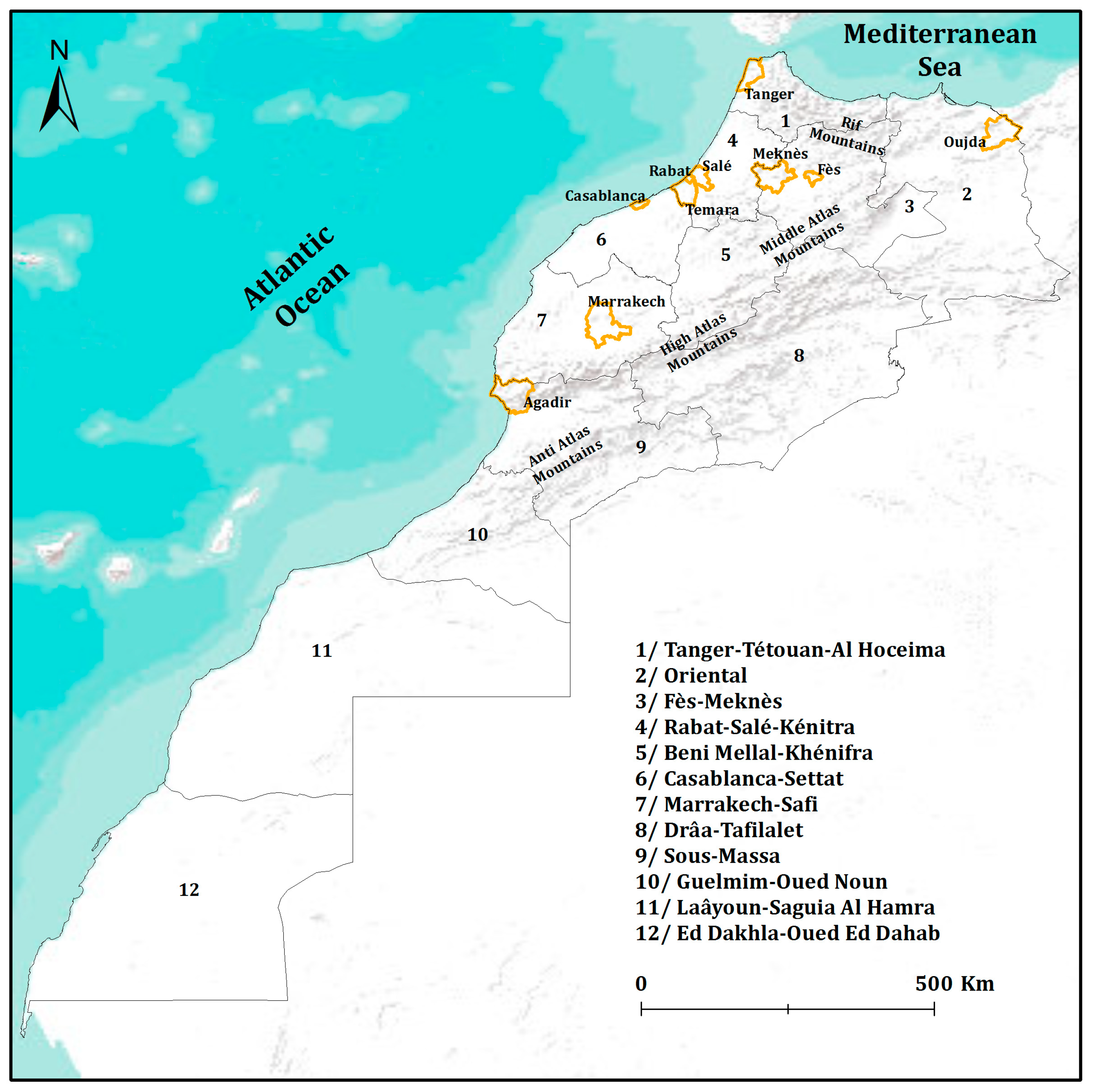

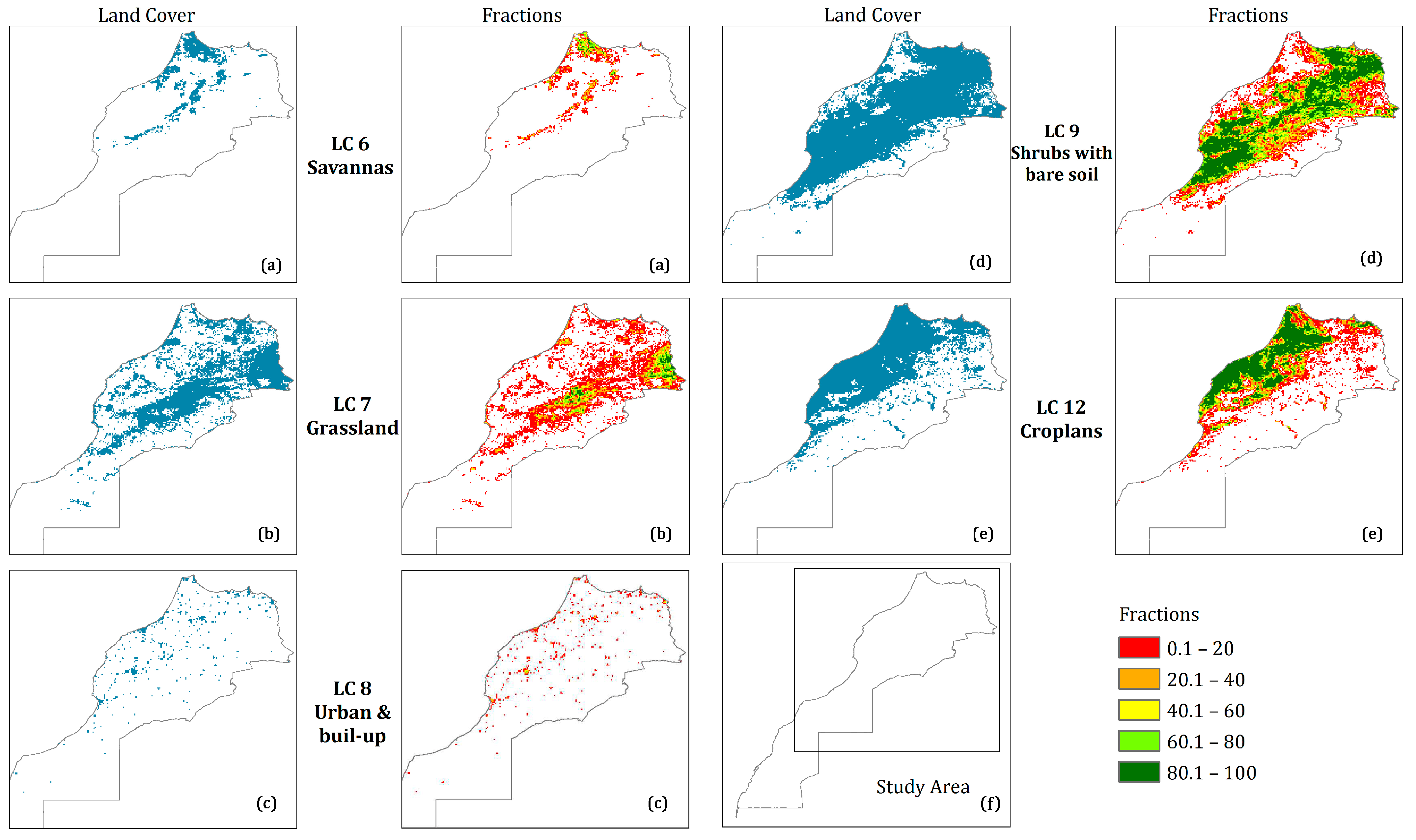

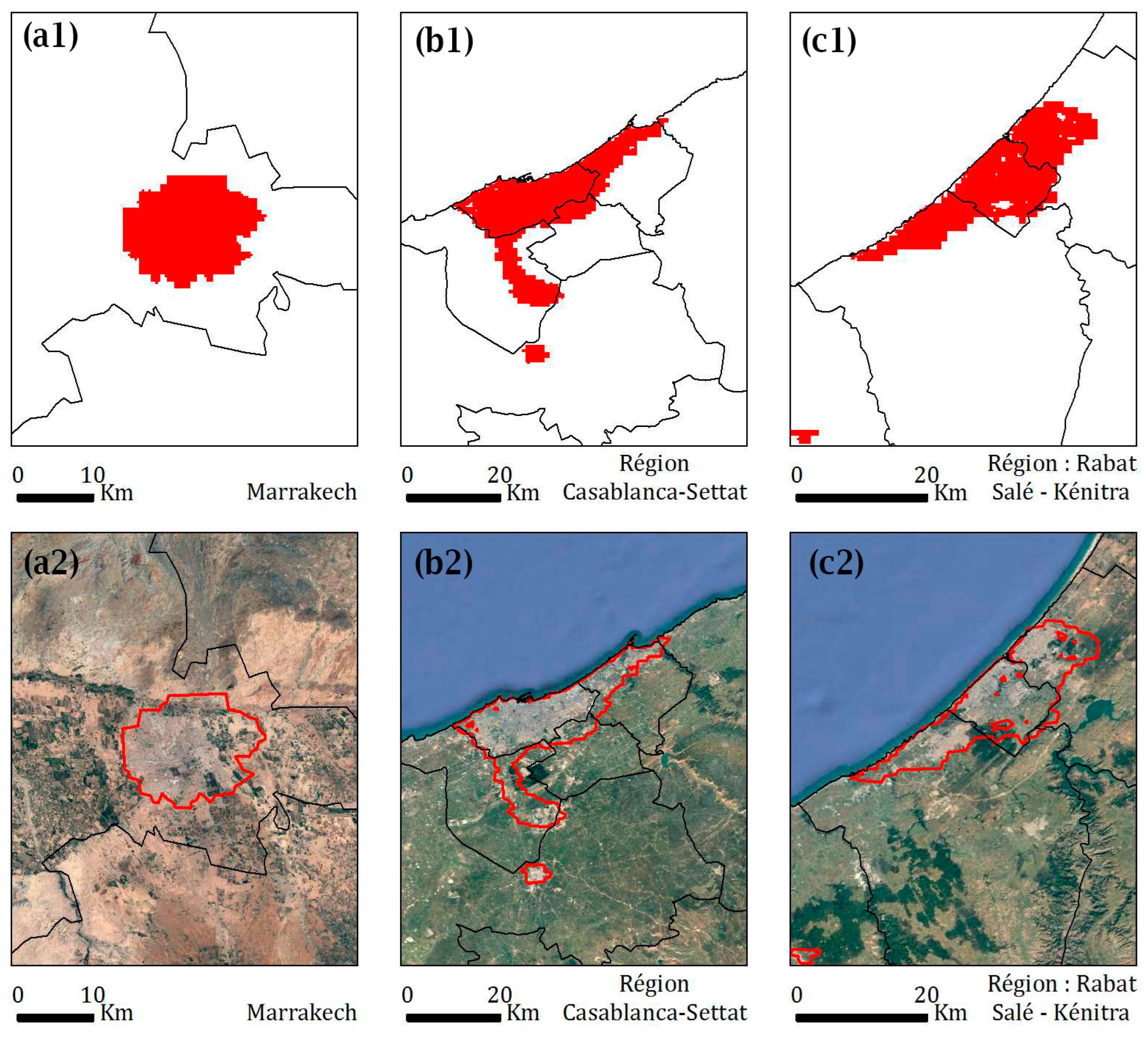
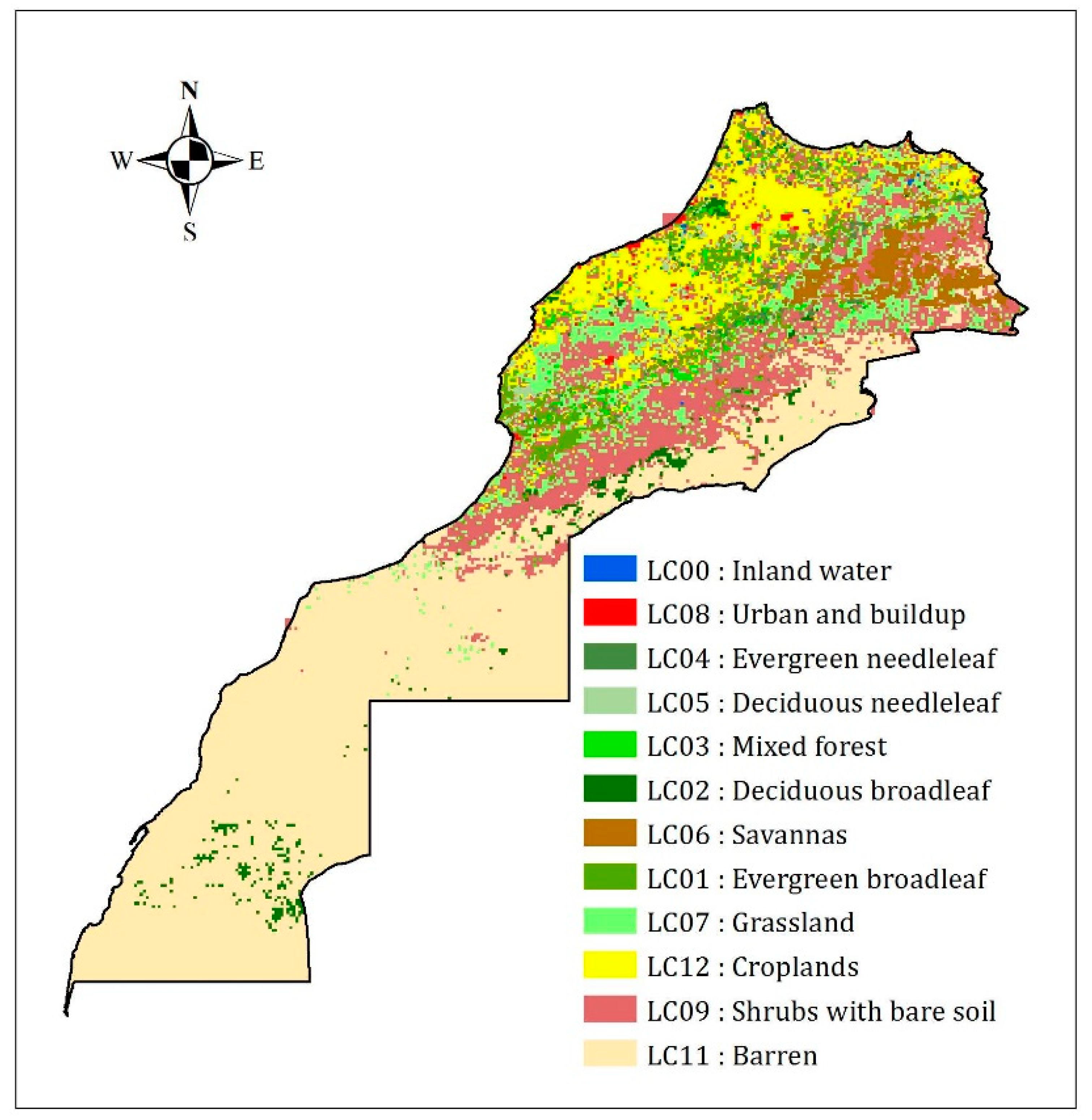
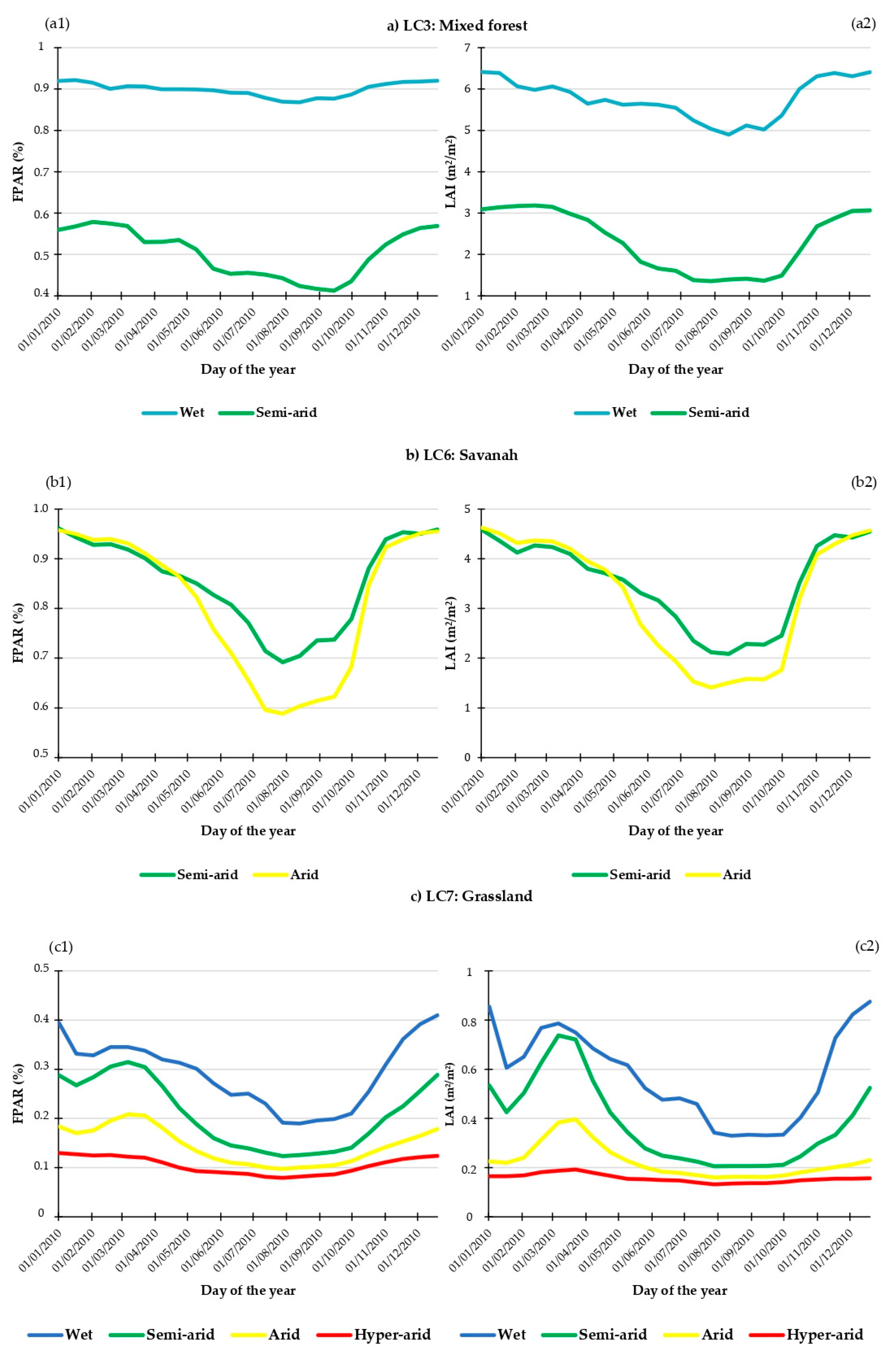
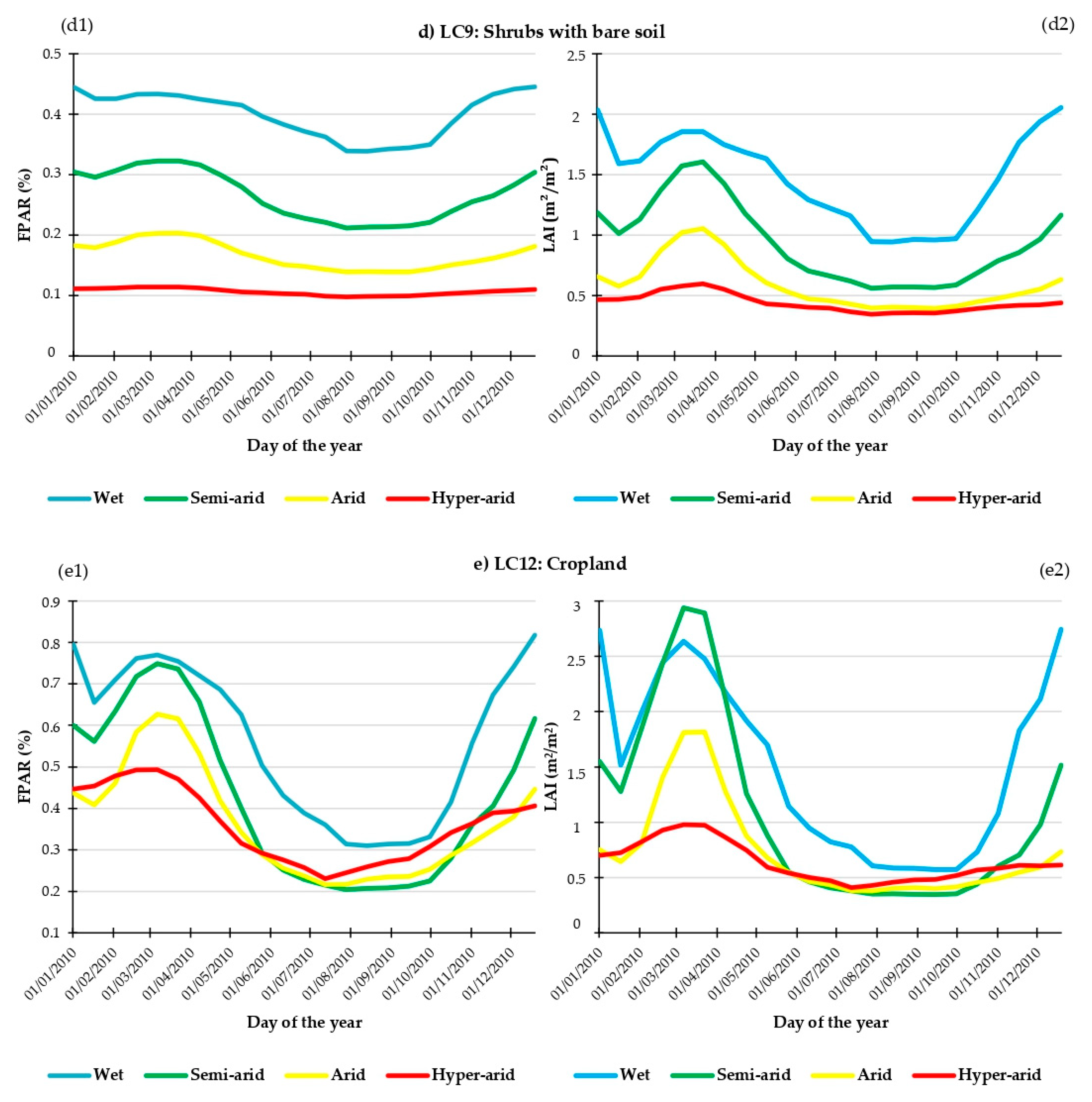
| Class | Code | Name |
|---|---|---|
| 00 | LC00 | Inland water |
| 01 | LC01 | Evergreen Broadleaf |
| 02 | LC02 | Deciduous Broadleaf |
| 03 | LC03 | Mixed forest |
| 04 | LC04 | Evergreen Needleleaf |
| 05 | LC05 | Deciduous Needleleaf |
| 06 | LC06 | Open and close Savannas |
| 07 | LC07 | Grassland |
| 08 | LC08 | Urban buildup (ISA) |
| 09 | LC09 | Shrubs with bare soil |
| 10 | LC10 | Tundra |
| 11 | LC11 | Barren/desert |
| 12 | LC12 | Cropland |
| Code | FAO | Sellers et al. 1996 [19] | SiB-Code |
|---|---|---|---|
| 11 | Post-flooding or irrigated croplands (or aquatic) | Cropland | 12 |
| 14 | Rainfed croplands | Cropland | 12 |
| 20 | Mosaic cropland (50–70%)/ Vegetation (grassland/shrubland/forest) (20–50%) | Cropland | 12 |
| 30 | Mosaic vegetation (grassland/shrubland/forest) (50–70%)/cropland (20–50%) | Savanah | 6 |
| 50 | Closed (>40%) broadleaved deciduous forest (>5 m) | Broadleaf deciduous trees | 2 |
| 70 | Closed (>40%) needle leaved evergreen forest (>5 m) | Needleleaf evergreen trees | 4 |
| 100 | Closed to open (>15%) mixed broadleaved and needle leaved forest (>5 m) | Mixed Forest | 3 |
| 110 | Mosaic forest or shrubland (50–70%)/grassland (20–50%) | Shrubland/Grassland | 7 + 9 |
| 120 | Mosaic grassland (50–70%)/forest or shrubland (20–50%) | Grassland | 7 |
| 170 | Closed (>40%) broadleaved forest or shrubland permanently flooded—Saline or brackish water | Grassland/Savanah | 7 |
| 190 | Artificial surfaces and associated areas (Urban areas > 50%) | Urban | 8 |
| 200 | Bare areas | No vegetation/Bare soil | 11 (desert) + 9 (bare) |
| 210 | Water bodies | Water | 0 |
| Plant Species from DEF | Sellers et al. 1996 [19] | SiB-Code |
|---|---|---|
| Zen oak | Broadleaf evergreen trees | 1 |
| Holm oak | Broadleaf evergreen trees | 1 |
| Cedar oak | Broadleaf evergreen trees | 1 |
| Argan tree | Broadleaf evergreen trees | 1 |
| Other deciduous trees | Broadleaf evergreen and deciduous trees | 1 et 2 |
| Deciduous reforestation | Broadleaf evergreen and deciduous trees | 1 et 2 |
| Saharan Acacias | Broadleaf deciduous trees | 2 |
| Tamarix | Broadleaf deciduous trees | 2 |
| Cedar tree | Needleleaf evergreen trees | 4 |
| Juniper trees | Needleleaf evergreen trees | 4 |
| Pine trees | Needleleaf evergreen trees | 4 |
| Softwood reforestation | Needleleaf evergreen and deciduous trees | 4 et 5 |
| Thuja | Needleleaf deciduous trees | 5 |
| Fir tree | Needleleaf deciduous trees | 5 |
| Alpha | Savanah | 6 |
| Type of Land Cover | Accuracy (%) |
|---|---|
| type 0 | 81 |
| type 2 | 100 |
| type 3 | 93.8 |
| type 4 | 90.3 |
| type 6 | 90.5 |
| type 7 | 98.7 |
| type 8 | 93 |
| type 9 | 14 |
| type 11 | 89.8 |
| type 12 | 87.2 |
| Mean | 83.8 |
| Type of Land Cover | Accuracy (%) |
|---|---|
| type 0 | 67.24 |
| type 2 | 87.69 |
| type 4 | 70 |
| type 6 | 64.44 |
| Mean | 72.34 |
Disclaimer/Publisher’s Note: The statements, opinions and data contained in all publications are solely those of the individual author(s) and contributor(s) and not of MDPI and/or the editor(s). MDPI and/or the editor(s) disclaim responsibility for any injury to people or property resulting from any ideas, methods, instructions or products referred to in the content. |
© 2023 by the authors. Licensee MDPI, Basel, Switzerland. This article is an open access article distributed under the terms and conditions of the Creative Commons Attribution (CC BY) license (https://creativecommons.org/licenses/by/4.0/).
Share and Cite
Thaiki, M.; Bounoua, L.; Cherkaoui Dekkaki, H. Using Satellite Data to Characterize Land Surface Processes in Morocco. Remote Sens. 2023, 15, 5389. https://doi.org/10.3390/rs15225389
Thaiki M, Bounoua L, Cherkaoui Dekkaki H. Using Satellite Data to Characterize Land Surface Processes in Morocco. Remote Sensing. 2023; 15(22):5389. https://doi.org/10.3390/rs15225389
Chicago/Turabian StyleThaiki, Mohammed, Lahouari Bounoua, and Hinde Cherkaoui Dekkaki. 2023. "Using Satellite Data to Characterize Land Surface Processes in Morocco" Remote Sensing 15, no. 22: 5389. https://doi.org/10.3390/rs15225389
APA StyleThaiki, M., Bounoua, L., & Cherkaoui Dekkaki, H. (2023). Using Satellite Data to Characterize Land Surface Processes in Morocco. Remote Sensing, 15(22), 5389. https://doi.org/10.3390/rs15225389








